Birth control pills scare the crap out of me. I recently researched the lower dose combination pill options and discovered that a single pill contains over 20 times the amount of estrogen your body normally produces. The pill’s job is to suppress progesterone, the pro-gestational hormone needed to get and stay pregnant. Taking this amount of synthetic estrogen– often for decades or more– leaves a women estrogen dominant.
Estrogen dominance is a precursor to many hormone-related cancers, such as breast cancer. Studies on the link between hormonal birth control and increased breast cancer risk do show that the pill increases breast cancer risk. It’s no wonder the pill comes with a packet of side effects a mile long. Side effects of birth control pills include the following:
- headache
- dizziness
- spotting, breakthrough bleeding
- breast tenderness
- weight gain
- decreased sex drive (the irony)
- nausea
- mood swings, depression, irritability
- yeast infections
- blood clots
- migraines
- decreased lubrication, painful intercourse
- altered levels of gut bacteria
- vitamin and mineral deficiencies
- increased risk of cervical cancer
- increased breast cancer risk
I should also mention a big side effect: DEPRESSION. Studies are showing the pill increases risk for depression, especially in teens. This was me. I started taking the pill in high school and experienced such severe depression that I would lock myself in the laundry room every night to cry. I had no idea why or what was happening to me. It was terrifying.
I took the pill on and off (mostly on) for a little over 10 years before I finally stopped. I desperately wish I’d known then what I know now. I started taking them in my teens and developed a yeast infection the first week I took them. I didn’t even know it was a yeast infection, having never had one before. I now know that’s a common side effect, because all that extra estrogen feeds candida that’s already present in the gut and vaginal canal, causing it to multiply and grow to unhealthy levels.
I would later experience chronic UTIs that disappeared for good once I quit the pill. A big cause of UTI is overgrowth of dysbiotic bacteria in the gut. I had no idea how profoundly birth control pills can adversely alter the gut microbiome. Once I stopped the pill for good, I went over a year with no period, despite taking prescriptions from my gynecologist to restore it. Fortunately I was studying women’s hormonal health at the time, and I stopped relying on conventional pharmaceuticals, turning instead to natural therapies to rebalance my hormones with great success.
One more noteworthy piece of info about hormonal birth control is that it changes the way you’re attracted to potential partners. Think about that for a moment. We are naturally attracted via pheromones to mates that have compatible immune systems to ours, meaning they’re different and will provide our offspring with more robust immune health. Women on the pill lack the ability to “sniff out” immune system compatible mates and end up choosing partners that aren’t biologically the best match or the most compatible. Disturbing. You can read the study here.
Types of Hormonal Birth Control Pills
The pill works by preventing ovulation and implantation, typically by thickening cervical mucous so the sperm can’t get to an egg. Though hormonal birth control is effective– 95% and up–it’s not without drawbacks.
- Combination pills contain synthetic estrogen and progestin. They may raise the risk of heart attacks, stroke, and blood clots. The FDA states that it has concluded that drospirenone-containing (a form of synthetic progesterone) birth control pills “may be associated with a higher risk for blood clots than other progestin-containing pills.” Pills containing drospirenone include Beyaz, Gianvi, Loryna, Ocella, Safyral, Syeda, Yasmin, Yaz, and Zarah.
- Progestin-only pills or injections (AKA the mini-pill) do not contain estrogen and are used by those over 35, cannot tolerate estrogen, and/or have risk factors that are exacerbated by combination pills. A “range of bleeding disturbances” may occur with progestin-only pills: amenorrhea, irregular, frequent, or prolonged bleeding.
- Extended-cycle pills and continuous-cycle pills (also combination pills) can be taken to suppress periods altogether. They include Introvate, Jolessa, Lybrel, LoSeasonique, Seasonale, and Seasonique. These alarm me the most, as you’re getting a dose of continuous hormones.
In my practice, I often see women on the pill struggling with migraines, weight gain, and deficiencies in B vitamins (including B12 and folic acid) and zinc. But the biggest issue I see is amenorrhea and infertility post-pill. I have many women clients who experience irregular or absent periods post-pill. Or they’re not ovulating and want to get pregnant. Most are estrogen dominant and/or struggling with GI issues. Taking synthetic hormones has a widespread impact on your body and hormone balance. Here’s all the info you need to transition off the pill and rebalance your hormones naturally.
How to Stop Taking Birth Control Pills
First off, although I am horrified by the long list of complications the pill may cause and the changes it imparts in the body, I understand first hand how difficult it can be to choose a healthy and sustainable birth control option. My favorite and most recommended method is the Fertility Awareness Method (FAM), which is, when used correctly, 95 percent effective. Highly recommend this book (it changed my life!) to learn more about it. Non-hormonal IUD is my second recommendation.
That said, if you’ve decided hormonal birth control is not for you, here’s how to rebalance your body post-pill. Your main objectives are to support liver detox, rebalance gut flora, and establish healthy estrogen-progesterone levels.
Remember that it is possible to get pregnant the first month you stop birth control, so make sure to use a backup method during this protocol! If you choose the fertility awareness method, use backup contraception for the first three months until you get the hang of it.
Some symptoms you may experience after stopping the pill include the following:
- Loss of menstruation (amenorrhea)
- Infertility
- Hypothyroidism (this happened to me)
- Acne
- Headaches
- Hair loss
- Depression, anxiety
- Blood sugar swings
- GI issues like yeast, gas, bloating
Step one: Don’t stop taking the pill in the middle of your pack. Wait until you’ve had your period or until you finish the pack, then don’t start a new one.
Step two: your first day of bleeding counts as day 1. When you get your period, begin tracking your cycle. Use an app like Kindara, or simply chart the days.
Step three: begin taking a probiotic to restore gut health. The pill greatly alters your microbiome, making you more susceptible to yeast, malabsorption, and even weight gain. I recommend this probiotic, which has specific strains to rebalance flora in the gut and vagina. Include plenty of fermented foods rich in probiotics to rebuild your inner ecosystem. I recommend this coconut water kefir and plenty of raw kraut/cultured vegetables. Aim for 1/4 cup daily at least. Also consider a complete gut reset, especially if you’ve noticed a worsening in digestive issues.
Step four: liver detox support. (click here for my recommended plan). It’s a great way to detox excess synthetic hormones and estrogen and support the liver, which is in charge of metabolizing all your hormones. A happy liver = healthy hormones. If you don’t want to do a full cleanse, take a liver detox supplement, and I also recommend taking DIM for a few months to support estrogen detox. Also get plenty of cruciferous vegetables; they’re superior for detox support and for detoxing excess estrogens.
Step five: take vitex for a period of 6 months to normalize progesterone levels. This was a crucial step that helped me get my period back. I sometimes also recommend bio-identical progesterone from days 14-28 of your cycle if progesterone is very low. Evening primrose/borage works great too for overall hormone balance and to combat PMS symptoms. Bonus: it’s great for skin.
Step six: make sure you are getting plenty of good fats such as butter, coconut oil, olive oil, avocado. Fats are the building blocks for hormones. Include foods that support liver detox and add plenty of fiber to bind up excess estrogens in the gut and assist in their excretion. I also recommend a multi to address any nutrient deficiencies. Critical vitamins and minerals for hormone balance are vitamin C, vitamin A, the B vitamins, zinc, and magnesium, so beef up (so to speak). The pill also depletes your B vitamin and zinc stores, so including grass fed beef, lamb, egg yolks, and oysters (you can get them canned and eat for a snack; they’re pretty good) can help restore levels. And get plenty of veggies of all types, especially leafy greens and cruciferous.
I recommend getting blood work to check thyroid hormone levels, estrogen and progesterone levels, vitamin D, B vitamins, iron, ferritin, and zinc to help you more accurately determine what your body needs.
Be aware that it may take several months to re-establish balance, or you may get regular cycles right away. How long you stay on this protocol depends on how your cycles return and how regular you are. If you want to get pregnant, begin charting your basal body temperature daily to see if and when you’re ovulating. Taking Charge of Your Fertility is an excellent resource for how to do this.
Consider saliva hormone testing after a couple months on this protocol. You want to get an accurate picture of where your hormones are so you’ll know if you need to adjust anything in the future.
Finally, a word about unpleasant periods: many of my female clients begin taking the pill initially because they have very heavy or painful periods. If that’s you, aim the figure out why. Estrogen dominance, fibroids, and poor diet are main causes. (more on how to make your period pleasant here)
Pin it!

Mary Vance is a Certified Nutrition Consultant and author specializing in digestive health. She combines a science-based approach with natural therapies to rebalance the body. In addition to her 1:1 coaching, she offers courses to help you heal your gut and improve your health. Mary lives in San Francisco and Lake Tahoe in Northern California. Read more about her coaching practice here and her background here.

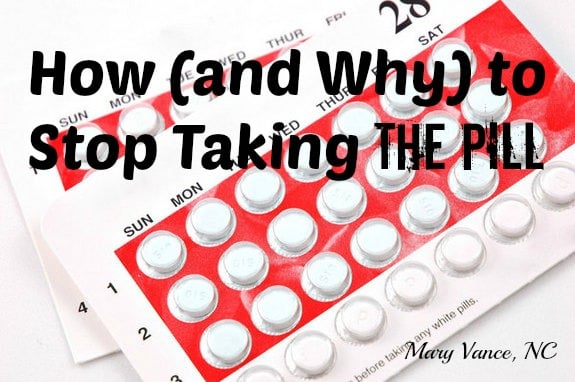
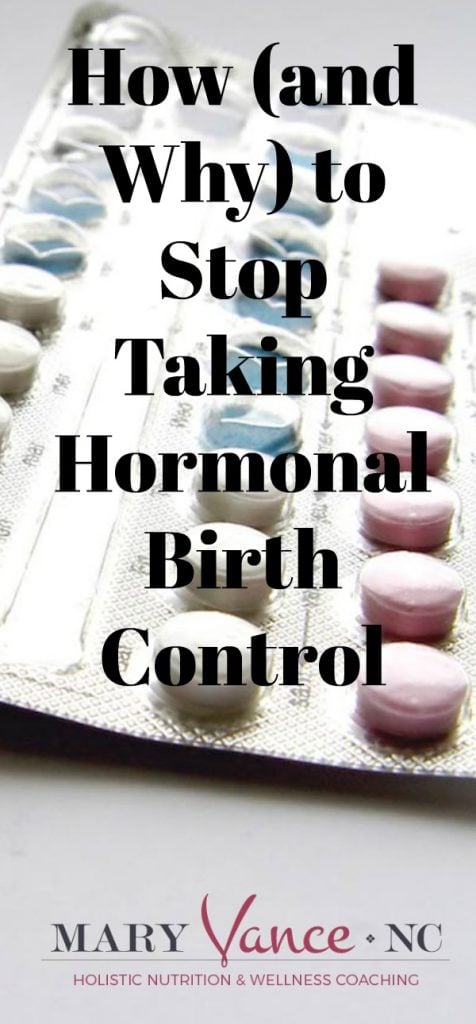
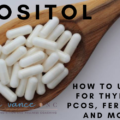

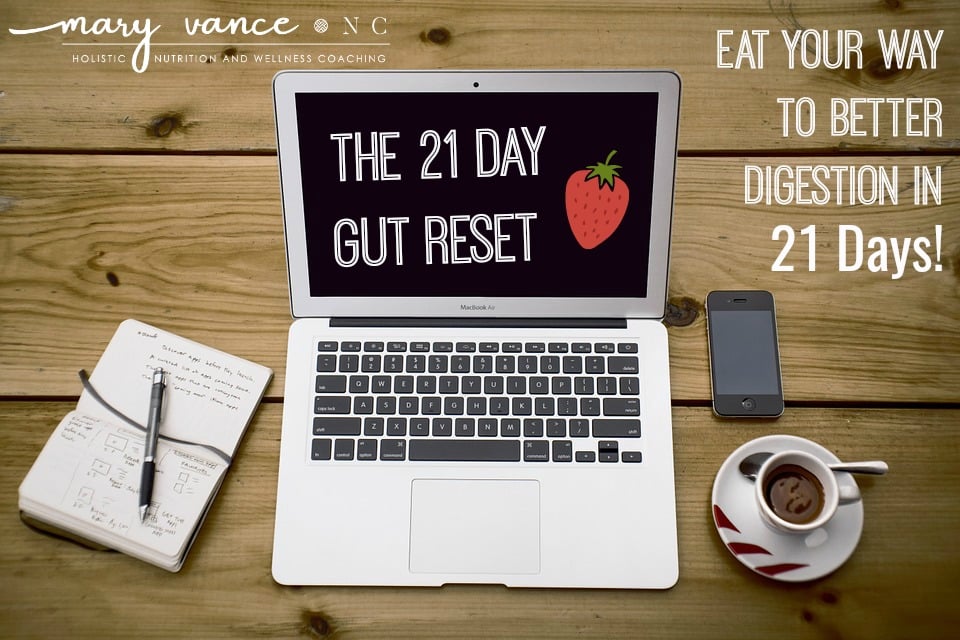
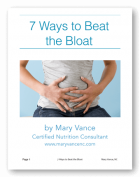
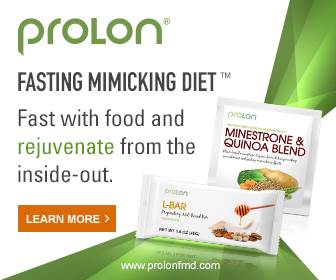

How do you feel about the paragard, copper IUD as a form of birth control?
It’s non hormonal, so it’s fine if it works for you.
I’ve read your article and have come back to it over the last couple months to re-read.
I took the Pill for 24 years not for birth control but for PCOS. Unfortunately, Over the last two years, I had developed debilitating migraines, painful varicose veins and blood clots. It finally occurred to me that it must have been the Pill.
So I stopped taking it in April and had a “normal” cycle that month, then again about 6 weeks later. Now, my PCOS symptoms have resurfaced full force, which is what I expected. I hadn’t had a period since around first week of June so I did the parsley tea trick (works every time). I don’t want a cycle so that I’ll get pregnant – that ship sailed a long time ago, I just want my body to work so that I don’t develop more issues on top of everything involved in PCOS.
I know what the doctor is going to tell me and try and put me on, which is not an option as with all medications, there are side effects. Instead, I’ve stopped all gluten, dairy, soy, corn and refined sugars, as well as increased supplements I know I’m not getting enough of that I can’t keep up with nutritionally. Unfortunately, we just moved to a small remote island in Alaska that has no naturopath so all I’ll get here is modern meds. I know this article wasn’t for PCOS, but I’m trying to figure out what estrogen does to help my condition and if I should be trying to increase the amount through foods or decrease. Not sure if you can answer that, more so, what amount is considered too much of estrogen and progesterone? Thanks in advance!
I can’t really give you an answer to a complex health issue without knowing more about your case. I’m happy to consult with you, or you can check out the book “PCOS Unlocked” that you can download for more info.
Another reason to avoid birth control pills : they affect the human microbiome. If you are not aware of the human microbiome, you should be, it plays an enormous role in human health.
Why do more women than men develop IBS-D ? For one, they take birth control pills, and two, they use cosmetics. Cosmetics are not even regulated by the FDA. That’s right, no oversight. So, I suspect there are ingredients in cosmetics that are also affecting the microbiome. Affect it enough, and you end up with disease………..
Yes, I discuss the importance of rebuilding the gut flora in the article.
Good information but I think it’s a good idea to mention or consider that some women are on birth control to suppress their period due to endometriosis. I have stage 3 and while I don’t want to take the pill, after I recovered from surgery, it has helped to quiet things down and slow the tissue growth. I wish there was an alternative but I risk infertility if my periods become heavy again. Thank you
Hi Laura, you bring up an excellent point. Sometimes BCP is medically necessary. Ideally, however, we seek to determine and correct the underlying causes of conditions like endo and PCOS that are commonly treated with BCP instead of looking at contributing factors like estrogen dominance or autoimmune conditions that exacerbate these conditions. But that’s not always possible in every case. If you must take the pill, a good probiotic and a multi along with liver support will support balance in the body.
Hi Mary! I am 42 years o,d female and had been mire a fir 12 years. Even though I didn’t really had any issues with the IUD, I wanted to free myself from the synthetic hormones. It has been 3 months now, my periods have been normal and on time. I am a clean eater and have been even more consistent lately doing more green smoothies and adding more veggies to the diet. I noticed since the past week, I have feeling light headed and dizzy. My overall health is great so don’t know what’s going on. I drink tons of water, no alcohol or sugary drinks. I am taking a DIM supplement, cod liver oil capsules and spearmint. I have lost 4 pounds the past few weeks, I am 114 now. Any advice will be appreciated.
Hi Dee, I’m happy to schedule a consult with you to discuss your health concerns. You can set up a time by emailing me via the contact page.
Hi Mary
I was wondering if you have any suggestions for women, like myself, who have experienced a sever hail loss after stopping the BC. I was put on the pill by my “so caring” GYN back in 2013 because my periods would come ever 2 weeks. W/o further evaluation, she decided that the pill would help. I stayed on it for a year and 1.2 and then decided to come off. Fast forward 3 months, my hair started to come out in bunches. I mean, it was scary. The fall continued for about 4 months, then slowed down, but my cycle was still struggling and my gyn decided to put me back on the pill. I hate myself for not doing more research on this subject.. the shed did slow down, but not completely by far. Few months into being on the pill, I decided to read up on the issue. Of course, I come across so many articles about women losing their hair after coming off the pill. I was stunned…and felt stuck. My plan was to switch doctors, see a dermatologist. By the time i saw one, another 2 months went by. He suggested to stay on the pill and do rogaine for a bit. He did prescribe the combo of Vit D, C, Zinc and I also took some iron, Ashwaganda and Omega 3. All that did slow don’t the shed and hair started to look much better— but I was still on the pill afraid to come off. Earlier this month I went to and IVF clinic bc i wanted to freeze my eggs… turned out my numbers are too low/too high 🙁 I think back in 2013, by body was trying to tell me something, and was silenced by the pill my doc put me on. I’m heartbroken to say the least. I’m coming off the pill this month…is there anything that you can suggest that would, perhaps, help the upcoming hair loss? Appreciate you advice.
Lara, sorry to hear that. I too have dealt with hair loss, and it’s a complex topic. You first need to have blood work with a complete thyroid panel (TSH, free T3, free T4), with iron, ferritin, estrogen, progesterone, DHEA, testosterone, B vitamins. BCP can contribute to hypothyroidism, hormone imbalances, and nutrient deficiencies that cause hair loss. This post may help: https://www.maryvancenc.com/solutions-for-hair-loss-in-women/
What do you suggest someone do if taking a probiotic and eating fat is not an option due to other health issues?
I would first recommend examining the underlying reasons why you can’t have fats or take probiotics and work on the existing health issues. Some people can’t tolerate normal amounts of fat because of gall bladder issues, and often taking pancreatic enzymes or digestive enzymes can help. Probiotic intolerance can indicate SIBO. But these 2 factors would not prevent one from successfully transitioning off hormonal birth control.
I’m looking to stop taking my BCP to get pregnant and because of the awful cramping and headaches I’m getting. I’m on seasonique and this is the second pack I’ve been on (went without BCP because of lack of insurance in 2017). I’m on week 6 of 13 and was wondering if you thought I should finish all 13 weeks or if I could stop it now because of these symptoms.
Hi Victoria, i’m sorry but i can’t advise you about any meds you’re taking. You’d need to contact your prescribing doctor and discuss with him/her.
Hi Mary
I’m wondering if u can offer guidance: I was on birth control (the pill and the NuvaRing) for about 8 yrs, stopped after ending a relationship then had 6 seizures in a 12month period, the first seizure being a month after stopping the pill. I was diagnosed with idiopathic epilepsy and put on topamax, after that year I went back on the pill and have been for about 7yrs now. I’m constantly bloated and my legs ache often, I am contemplating stopping the pill again but do not want to suffer from seizures….have you had any experience with this? I can’t seem to find any literature on if/how seizures are related to B.C. and my doctors have been no help unfortunately. Any advice/help/direction would be greatly appreciated.
Is there any particular reason you mention finishing a pack before you stop taking BC? Is there any risk/downside to stopping mid-pack?
Austen, probably no risk, but you’ll get breakthrough bleeding and potentially alter the regularity of your cycles.
Hi Mary, I am 23 years old and suffer from ovarian cysts and I need your help. In 2015 I lost my right ovary from ovarian torsion, I was put on BC right away and my body did not react well to it. I am now on the nuva ring but still get occasional cysts while using this method. I feel super hormonal and have dry nipples and very emotional. I’m currently on my period and debating whether or not to stop my BC method (nuva ring) and see if my body can balance itself but I don’t know how to do this and I am afraid of losing my only ovary that I have left. Please help me because I feel completely lost and shoved to the side by my doctors who just keep prescribing BC to me when I know my hormones are out of wack.
Hi Rebecca, sorry to hear that. You might check out Jolene Brighten’s info about hormonal BC how to support health if you have to take hormones (Or how to transition off hormonal BC you decide to do so): https://drbrighten.com/post-birth-control-syndrome/
Hi Mary I would like to ask if how to stop taking a contraceptive pills to prevent pregnant ,because I use pills and I want to stop it but I dont want to get pregnant because my menstruation didn’t come almost 5 months .
Hi Cathy, check out the book I recommend in the post about the fertility awareness method. You can also use non hormonal IUD.
Hi Mary,
For the past few months I’m experiencing bloating, constipation and mild pain and discomfort in my stomach during the day. The bloating goes away most of the time during the night.
I took saliva test for candida and it showed the presence of it.
I’m taking birth control pills for almost 13 years (I’m 42 years old), mostly because of my hormone imbalances. Right now I’m on Seasoniqe.
I’m afraid to get off of BC (because I get really hormonal, depressed and feeling down), but I am struggling with this bloating issue.
I changed my diet completely (no dairy, wheat, sugar, …) and following FODMAP diet.
Is there anything that I can do to put my gut into a better place? I’m taking pre-and pro- biotics, eating fermented foods, drinking kefir, eating healthy fats, and some days I just get so bloated that I look pregnant.
I’m not overweight person, eating very healthy most of my life, not drinking alcohol or eating sweets very often, so I really don’t know where this is coming from.
I might go to my naturopath and ask for candida cleanse products. I don’t know what else to do anymore.
Any suggestions?
Thanks in advance.
Hi Tatjana, if you have confirmed candida, you would be a great candidate for my candida course: https://www.maryvancenc.com/product/candida-cure-masterclass/
You should also consider testing for SIBO. Also note that fermented foods may make candida (and SIBO and SIFO) worse.
Hi Mary, I’ve been on the pill for almost 20 years. I’ve taken a few years off here and there – one as a break because I was sick of putting synthetic hormones into my body, and the other a four-year break to have my children. I’ve been back on the pill for almost a year now, and I’d really like to stop because of recurring yeast infections. Every time I’m off the pill I have terrible skin – breakouts. I think it’s hormonal, because every time I’m back on the pill , my skin smooths out again. Any ideas/ suggestions?
Hi Tam, hormonal acne is a tricky one. Sometimes it will gradually subside over time, but you could work on estrogen detox using DIM and calcium glucarate. Also tending to gut health is important, as the health of the gut impacts skin health. A good probiotic is a must + a gut healthy diet with plenty of omega 3s. Of course if can be difficult to navigate all this solo, so it can help to work with a practitioner!